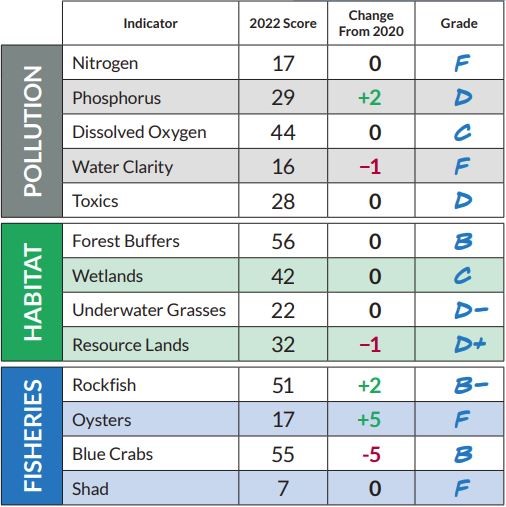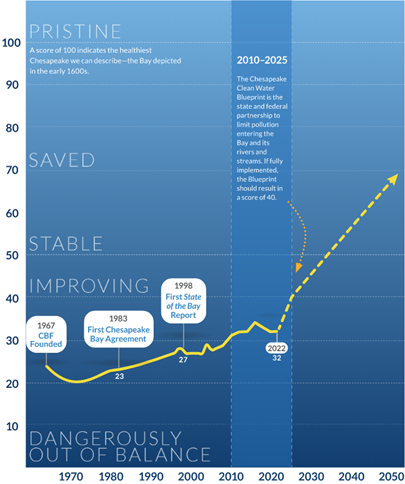The Chesapeake Bay scored a 32 on the 2022 State of the Bay report. This is the same score the waterbody received on the 2020 State of the Bay report. The Chesapeake Bay Foundation (CBF) issues a biennial State of the Bay report that analyzes the best available information about the Chesapeake Bay cleanup efforts. The report uses a number of indicators to determine how progress has been made. This includes looking at levels of pollutants like nitrogen and phosphorus as well as population numbers of oysters, rockfish, and other keystone aquatic species. Each indicator is given a score and associated grade. Those scores are used to determine the overall health index of the Chesapeake Bay.
The largest score jump came from the oyster category, which had a score increase of five points. Oysters are important members of the Chesapeake Bay ecosystem. They filter sediment and nutrients from the water, provide habitat for juvenile rockfish and other fish species, and are a staple of the region’s food culture. The blue crab’s score dropped five points, representing the largest score decline out of all indicators.

Image 1. 2022 State of the Bay Indicator Scores.
When the first State of the Bay report was released in 1998, the Chesapeake Bay scored a 27 (D). Scores have been up and down over the years, but the long-term trend shows that cleanup efforts are having an impact on the health of the Chesapeake Bay and the watershed as a whole.
The Chesapeake Bay would receive a score of 40 (C) if the Chesapeake Clean Water Blueprint were to be fully implemented. This means that enough Best Management Practices have been installed to help the Chesapeake Bay reach its cleanup goal. A milestone has been set to have all practices installed by 2025. The cleanup effort would need to see great acceleration to achieve this goal. Watershed partners have stepped up their efforts to make a push to reach the goal. The James River Association and Chesapeake Bay Foundation operate a cost-free tree planting program for Upper and Middle James River Watershed landowners. Landowners who would like to see more trees planted along streams on their property can enroll in the program to establish riparian buffers on their property. Virginia lawmakers have also worked to pass legislation that supports cleanup efforts. The 2021 General Assembly session saw hundreds of millions of dollars become allocated towards wastewater treatment facilities in need of upgrades. These improvements will enhance the treatment process and reduce pollutant loads coming from treatment plants.

Image 2. State of the Bay progress graph.
The Roanoke Valley-Alleghany Regional Commission is supporting the cleanup effort by facilitating conversations about the Chesapeake Bay and finding opportunities for communities to complete water quality improvement projects. Learn more about water quality initiatives in the area at upperjameswatershed.org. Contact Gabriel Irigaray, [email protected], for more information about how to complete a water quality improvement project in your community.
